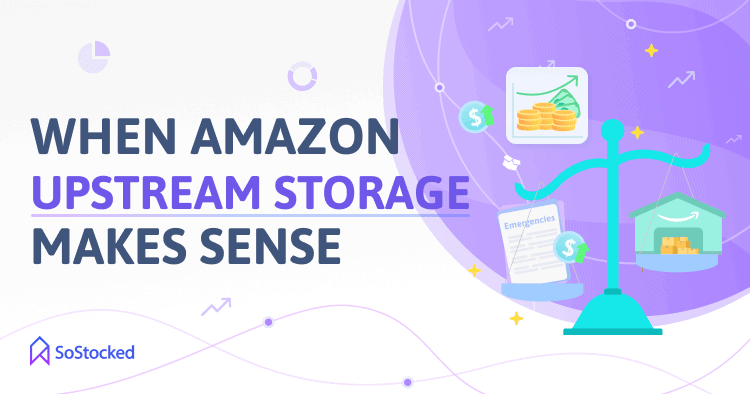
Is Amazon Upstream Storage Right For You?
Alternative Shipping & Storage Solution to Supply Chain Issues
Over the last two years, Amazon has been focused on creating more space in their fulfillment network to meet high customer demand.
In 2021, the eComm giant launched Amazon Upstream Storage, a low-cost bulk storage solution for shipping and storing FCL (Full Container Load) shipments in an upstream facility. It’s a warehouse where Amazon initially receives and prepares inventory for distribution across its fulfillment centers (FCs).
Then, from an upstream facility, Amazon automatically transfers replenishment units to Prime-ready fulfillment centers based on your FBA inventory needs to ensure you stay in stock.
For third-party sellers affected by capacity constraints at FBA, the new program might be a good way to keep larger amounts of products in the US and make inventory transfers more efficient, especially during key selling periods like Prime Day and Christmas.
However, as with all other Amazon programs, Upstream has a few drawbacks that might make you reluctant to use it for your business.
Continue reading to learn the pros and cons of Amazon Upstream Storage so you can make an informed decision.
In this Amazon Upstream Storage guide, we’ll take a look at:
What is Amazon Upstream Storage?
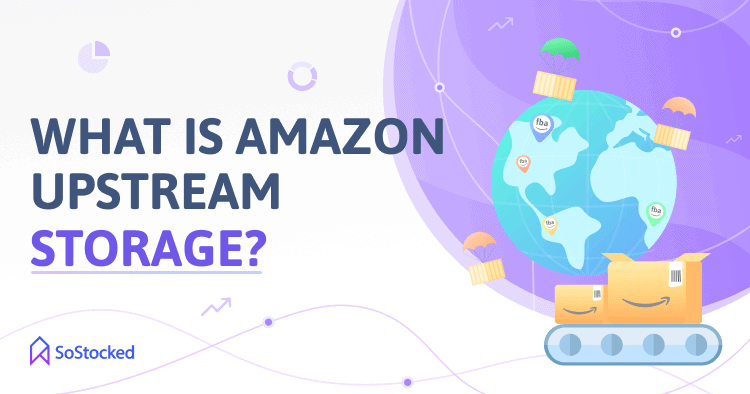
Amazon Upstream Storage is a new distribution program that aims to streamline inventory restocking in Prime-ready FCs. Amazon is currently testing the program with a limited number of FBA sellers and should be rolling out more widely sometime in 2022.
How Does it Work?
Amazon uses upstream facilities, also known as inbound receiving centers, to receive and store your FCL shipments directly from your supplier. From there, the online retail giant relies on its sophisticated technology to track your inventory levels at its FCs and replenish stock as needed.
Think of these upstream facilities as a place for inventory staging, where Amazon keeps a set amount of goods in a warehouse close to where packing and shipping will take place. It’s likely that these warehouses will be strategically located within a day’s drive to Prime-ready FCs to speed up transit times.
7 Top Features and Benefits
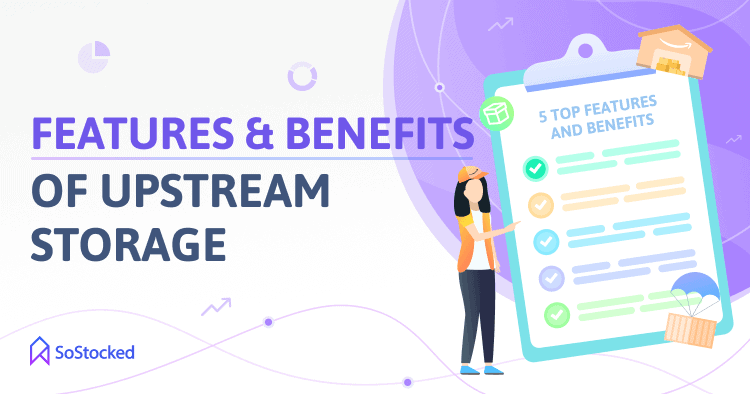
- No restock or storage limits. FCL shipments kept in an upstream facility will not be counted against your current restock, inbound, and Inventory Performance Index (IPI) storage limits. If you’re running low on stock and your current restock limits are preventing you from sending in additional units, consider using Amazon Upstream as an alternative warehouse to alleviate storage constraints at FBA.
- Efficiently move your import goods through Amazon Global Logistics (AGL). When sending FCL from your supplier to an upstream facility, you may opt to ship it through AGL, Amazon’s proprietary freight service. It allows you to import goods from your factory in China or Hong Kong to Amazon US, Canada, UK, among other marketplaces without the need to hire a 3PL company. Removing 3PLs from your supply chain essentially decreases the number of contact points in your process, thereby minimizing both lead time and FBA check-in times. Amazon also assigns optimal FC destinations for your shipments and allows their partner carriers to schedule early delivery appointments with them to ensure products get checked as quickly as possible.
- Ship directly from your 3PL warehouse. According to an insider who has been working closely with one of the team leads at Amazon Upstream, you may also opt to directly send your inventory from your 3PL in the US to an upstream facility. It would work in the same way as setting up a shipment to an FC with shipping plans, FBA labels, and so on. So, aside from AGL being optional, your inventory also doesn’t have to come straight from your factory.
- Integrated Amazon transportation. Amazon takes care of the delivery of your replenishment units from their upstream facility to Prime-ready FCs. Transfer lead time is anywhere between one and seven days.
- Auto-restocking and In-Stock Head Start eligible. The program uses a technology that triggers auto-replenishment to Prime-ready FCs to help you avoid stocking out. You also get to enjoy the benefits of the In-Stock Head Start program, a paid service that allows customers to find and purchase items from your store, even when they are temporarily out-of-stock. If you have a shipment that’s on its way to an FC or have enough inventory in an upstream facility, Amazon will use that information to determine the in-stock date for your products and provide your customers with an estimated delivery date. Conversely, if you don’t have any inbound shipment or Amazon anticipates a long shipping delay, a “Temporarily Out of Stock” message will be displayed on your product listing.
- Lower storage costs. According to Amazon, upstream storage fees are up to 63% lower than those of fulfillment centers. This is because FCs are usually bigger than inbound receiving centers. They also contain more valuable shelf “real estate” because the inventory there needs to be available and ready to process to customers immediately. Amazon needs as wide a variety of inventory as possible to avoid stocking out of items that should be available for Prime shipping. Additionally, many FCs are located near population centers, and therefore more expensive to operate.
In contrast to FCs, upstream facilities are usually built outside of major cities and don’t need a lot of automation, as they’re mainly used for keeping FCL shipments until they’re needed. Upstream storage also comes with no overage fees that Amazon usually applies to aging inventory stored in their FCs. - Pay-As-You-Go (PAYG) pricing. As the term suggests, PAYG means paying for the services that you need when you use them rather than paying before or afterward. Since you only pay for the storage space or services you consume, there’s less risk of overspending compared to 3PLs that can have monthly minimums. And once you stop using the service, there are usually no termination fees or additional costs versus 3PLs that may charge a fee when you terminate your contract with them early.
6 Reasons Why the Program Might Not Be For You
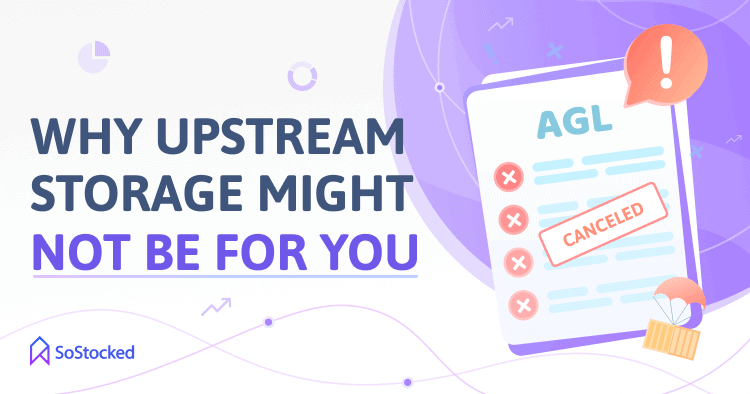
- If using AGL, account registration is required. You’ll have to get approved for an account on AGL to be able to send your FCL shipments to an upstream facility. Unfortunately, getting started with AGL can be time-consuming, as there are a lot of hoops to jump through, such as setting up an Importer of Record and Customs Compliance information for your products. Click here to learn more.
- AGL services are more expensive than third-party freight forwarders. According to eCom Crew, AGL is approximately 20% to 30% more expensive than other freight forwarding services, although the faster lead and check-in times and 3PL fee savings may make up for the high costs. Either way, you should run some numbers and see if the math makes sense.
- Limited to standard-size products only. The other big thing to consider is that it seems that Upstream facilities don’t allow for oversized goods, only standard-sized, according to our source, so sellers of oversized products cannot, at this time, take advantage of the program.
- Inventory transfers are limited to Prime-ready FCs only. This means you can’t move your replenishment units from an Amazon upstream facility to non-Amazon destinations or use the inventory for FBM, essentially forcing you to rely on Amazon’s shipping infrastructure.
- Potentially risky program. Amazon Upstream is still in its infancy, so it may not be as streamlined as you want it to be. Imagine turning over an entire FCL to Amazon and their carriers suddenly encounter a significant shipping delay – yup, every seller’s nightmare! This is why it’s crucial not to put all your eggs in one basket.
- Inventory from upstream now incurs FBA fees once at FBA. Until recently, products coming from AMZ Upstream (now renamed Amazon Warehousing & Distribution or AWD) had reduced storage fees for the life cycle of their time in the FBA system. Depending, of course, on your storage tier, the upstream storage costs ranged around $0.63/$1.20 (4th Quarter) compared to the standard FBA rates of $0.82/$2.40 (4th Quarter). If your product gets replenished to an FC via an AWD facility, it keeps those same reduced storage costs until the product is sold. However, that’s not true anymore. According to a source familiar with the matter, if inventory moves from AWD to FBA, sellers will stop incurring the reduced AWD storage costs and begin incurring FBA storage costs.
However, some sellers are still willing to take that risk. We hope that Upstream will become more polished as it rolls out to more sellers in 2022, although Amazon has not said how long the beta testing will last or how many upstream facilities they intend to establish if the program pushes through.
Alternative Storage and Shipping Options
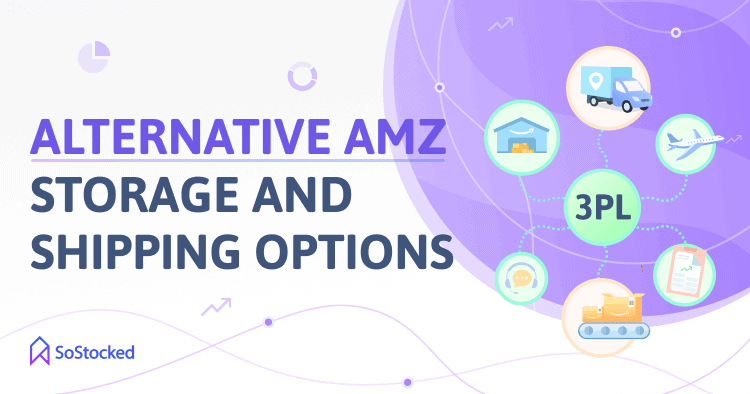
Since it’s risky to put all your inventory in just one warehouse, it would be wise to also invest in alternative storage and shipping providers to ensure you have some buffer stock in other places in case Amazon loses an FCL shipment or it gets stuck at the port.
Consider the alternatives below:
3rd-Party Logistics (3PL) Providers
3PL is the outsourcing of logistics processes to a 3rd-party provider. These processes typically include inventory management, warehousing, and replenishment. Some 3PLs also do order fulfillment, also known as third-party fulfillment.
3PLs are especially useful during chaotic times, as they can help you remain flexible no matter what happens. To reduce frequent air express shipping due to stockouts, for example, you could store a portion of your FCL cargo or buffer stock in your 3PL warehouse instead, and from there, ship LTL shipments to Amazon FCs as your restock limits allow.
And in the event Amazon fails to receive or check in your Less than Truckload (LTL) shipment on your desired schedule, you could use some of your available stock back at your warehouse and ship those to Amazon via Small Parcel Delivery (SPD). Small parcels are lighter and easier to handle, thus faster to check into FBA, which makes SPD a more reliable option for emergencies such as avoiding a potential stockout, though it is more expensive than LTL.
You could also sell your inventory via FBM, if you’ve maxed out your FBA restock limits or are dealing with other FBA restocking challenges.
Related: 3PL Logistics Backup for Amazon
Your Supplier’s Warehouse
Another effective contingency plan is holding back a good amount of inventory with your supplier, say an extra month or two worth of stock. If your shipment is stuck at Shanghai or Los Angeles port for a few weeks, for example, you can ask your supplier to quickly send a portion by air to avoid stocking out.
Just like the 3PL buffer stock strategy, this plan can also help you to prevent stockouts and minimize costly express air shipping, as some units are kept at all times just in case they are needed.
Related: How to Ship to Amazon FBA (And Speed Up Check-in Times)
Track Your Amazon Shipments With SoStocked
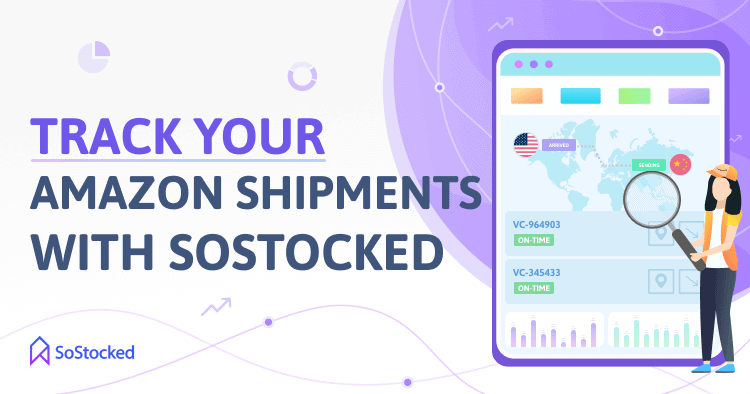
Conveniently track all of your shipments from overseas to the US by using:
Purchase Order (PO) System with Lead Times
Use our built-in PO system to generate inventory orders and assign lead times to each order to be able to track them inside SoStocked. Use this system along with our Work Order (WO) system, which allows you to set transfer times for processing and shipping replenishment units from your 3PL warehouse or prep center to Amazon FCs.
Click here for more information on how the SoStocked PO system works.
Order Tracker
Once you’ve assigned a lead time to your PO, you can now track the movement of your on-order inventory through our Order Tracker Dashboard. Use this dashboard to view POs In Production > En Route > Arrival at FBA or your 3PL.
Related: 11 Ways Amazon Inventory Trackers Improve Inventory Management
Inventory Tracking Dashboards
Achieve maximum visibility into your supply chain using our Inventory Tracking Dashboards. These dashboards are designed for tracking both inbound shipments and real-time inventory levels at Amazon and 3PL.
- Inbound Shipment Dashboard. Use this dashboard to find out which POs or WOs are arriving at Amazon or your 3PL.
- Inventory On-Hand Dashboard. This dashboard lets you view all of your Inbound, Available, and Reserved Inventory at Amazon. You can also view your warehouse stock, inbound total stock, and total stock plus inbound.
- Warehouse Level Dashboard. Use this dashboard to determine your inventory level by ASIN and warehouse.
Bonus: How Flexibility & Optimization Can Recover Your Margins Webinar
When Does it Make Sense to Use Amazon Upstream Storage?

The main factors you need to keep in mind when deciding whether to use Amazon Upstream Storage are cost and convenience.
While the program basically takes loads of logistics work off your back (shipping via AGL, warehousing, and distribution), the overall costs might be higher than most 3PLs or freight forwarding companies out there.
That said, Amazon Upstream may be a good option if it’s more convenient for you to keep all your FCL shipments in an upstream facility and the sales from those shipments would offset your upstream storage fees and savings on 3PL logistics costs.
You might also want to use this service if your restock limits or IPI scores are very restrictive, as units stored in upstream facilities are not subject to Amazon storage limitations.
But as I’ve said earlier, it’s not ideal to put all your eggs in one basket.
For that reason, consider having a backup 3PL warehouse for emergencies and track your inventory to ensure there’s always enough stock to fulfill orders.
Related: Amazon Enters 3PL Space with New Warehousing & Distribution Program
Need more information?
- Send Message: We typically reply within 2 hours during office hours.
- Schedule Demo: Dive deeper into the nuances of our software with Chelsea.
- Join Live Upcoming Webinar: New to Amazon inventory management? Learn three inventory techniques you can implement right away.
 Start Your Free Audit
Start Your Free Audit